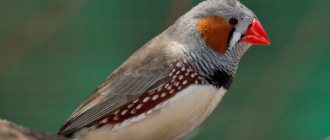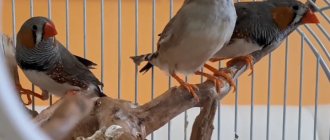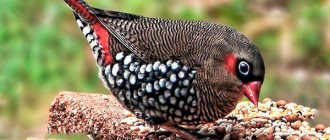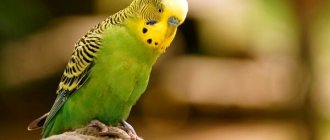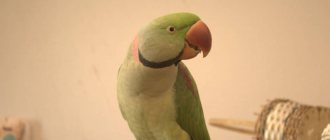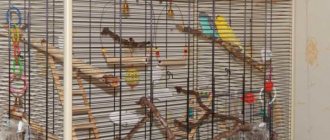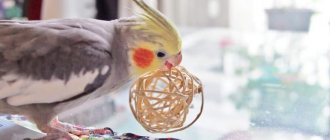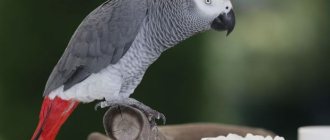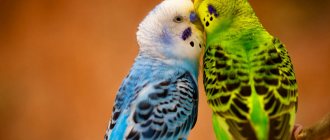Types of housing for keeping finches
First you need to decide where the finches will live. There are several options for placing these birds:
- cell;
- aviary;
- cage
The choice of housing for finches largely depends on how many individuals will live together. A regular small cage is suitable for keeping a couple. Aviaries are used for flocks.
Cages are designed for keeping and raising young animals.
Cell
Even if the future owner of the finch birds plans to keep them in a spacious enclosure in the future, a cage will still be needed. It is necessary for isolating and caring for sick individuals, as well as for the quarantine period when purchasing new feathered pets.
Pet stores offer a large selection of cages for keeping birds, but not every one is suitable for finches. Experienced owners agree that it is more convenient to care for birds in a rectangular-shaped dwelling, which is made of a metal lattice.
To keep one pair of finches, a cage with dimensions exceeding 50x30 cm is suitable, this is the minimum size. The height should not be less than 50 cm.
Attention! Keeping finches in close quarters is unacceptable - they can damage the plumage. In addition, in cramped conditions, birds become less mobile and quickly gain weight. This negatively affects the health of finches and their ability to reproduce.
When purchasing a cage for finches, you should choose a design with a removable plastic tray. It is more convenient to maintain such a home - clean and wash it. You should pay attention to the distance between the rods. It should not exceed 1 cm. It is good if the grille is covered with enamel.
The cage for finches must be equipped with a securely closing door. It's better if there are several of them. This makes it much more convenient to care for the nesting house and clean the feeder and drinking bowl.
Display cages are very popular. They resemble a box, the sides of which are made of wood or plastic. The front wall is made of lattice or plexiglass. The second option is less preferable, since air exchange is difficult in it.
Aviary
To keep several finches, it is recommended to equip an aviary, especially if they have a pronounced territorial instinct. The minimum size of the structure for 4 or more birds is 2x1.5x1.5 m.
To ensure that finches use all the available space, you need to place feeders and perches correctly. Food containers are fixed in the lower part of the enclosure, and additives are fixed in the upper part.
Zadok
The cage is smaller in size than the enclosure, but still quite spacious, so it is quite suitable for keeping a pair of opposite-sex individuals. It can also be used to care for finches chicks that have been separated from their parents. The cage has a rectangular shape.
The average size of the structure is 100x60x40 cm.
When choosing a cage, preference should be given to one that is equipped with a damper at the bottom. This will prevent the finches from flying out of the tray slot during cleaning.
Socket options
The appearance of a nest is a signal for the beginning of the mating season. For a pair of finches, at least 2 nests are installed in the enclosure. Manufacturers themselves choose the appropriate one. You can offer birds the following nest options:
- Open basket. Constructed from willow twigs, vines or hemp rope. Has an open top.
- Closed basket. It is woven from willow twigs. It looks like a ball with a small entrance.
- Open box. Made from plywood. Does not have a front wall. Equipped with a removable lid and has a recess at the bottom.
Equipment for cages and enclosures for keeping finches
Caring for finches at home will be easier if you immediately equip the bird’s home correctly. Filler is poured into the bottom of the cage - sand, fine gravel or wood shavings. The feeder for finches is fixed at the bottom of the structure. It is important that she is not under a perch, otherwise droppings will get into the food.
Finches will need 2-3 perches for resting, 0.8-1.2 cm thick. They should be fixed at different heights so that the birds can move comfortably inside. If the owner plans to start breeding birds, he will need a nesting house for finches. A drinking bowl is also needed.
It is better to give preference to the one that is attached to the outside of the grille. Another small feeder is attached next to the perch. Mineral supplements are placed in it.
Another important attribute for keeping finches is a bathing container. It can be made of glass or plastic. Bathing suits can be mounted or floor-mounted, closed or open. The container, which is equipped with three walls and a canopy, prevents splashing of water, but it requires more careful care.
Microclimate
It is advisable to clean the finches' cage every 4-5 days, otherwise the filler will become a breeding ground for bacteria. Dirty sand is poured out, the tray is cleaned with a scraper and washed with hot water. The finch's feeder and drinker are emptied and scalded with boiling water. If necessary, clean the grate with a brush.
Attention! Every 3-4 weeks it is recommended to treat the cage and tray with a choramin solution at a concentration of 2%.
Light mode
The suitable duration of daylight hours for finches is 12-13 hours. Therefore, it is advisable to place the enclosure in a room with a lot of natural light. Its deficiency will lead to health problems for birds.
When keeping finches in a private house in the summer, it is worth taking them out into the yard and leaving them in openwork partial shade on the street. This will help avoid the development of rickets. In autumn and winter, when twilight comes early, you need to use special lamps to increase daylight hours.
Humidity and temperature
It is important to maintain the correct temperature in the zoo corner. The thermometer should not fall below +16 and rise above +25 degrees. Extreme heat reduces appetite and slows down metabolic processes in birds.
To ensure good maintenance and proper care of finches at home, you need to constantly monitor the level of humidity in the room. It should be in the range of 55-70%. Excessive dry air leads to brittle feathers and flaking of the skin.
Due to low humidity, finches more often suffer from respiratory diseases, as the mucous membranes of the nose and mouth dry out.
The right time for breeding
Amadins in captivity are able to bear offspring at any time of the year. The incentive for finches to start breeding is an increase in daylight hours and an increase in temperature, so it is more convenient to plan the appearance of chicks for the summer period. In winter, in order to produce offspring, you will need to additionally illuminate the room with the breeders and ensure that there are no drafts.
Amadina: from egg to adult bird
Japanese finch
Japanese finches are very rarely found in the wild - this species was bred by breeders. It appeared due to the crossing of the bronze manakin with the Chinese species of finches. It is called Japanese because it came to Europe from Japan. Japanese finches are the best mothers of all 38 species. They even hatch other people's eggs and treat the chicks as if they were their own.
Feeding finches
Birds must receive a variety of food, only in this case they will be healthy all year round.
The amadin's diet is based on a grain mixture, which consists of various types of millet. Seeds of flax, dandelion, plantain, shepherd's purse, timothy and other herbs are added to the food of these birds. In addition, the mixture includes peeled oats and a small amount of rapeseed.
In summer, finches can be given seeds directly in the spikelets of plants. The main thing is to collect them away from the roadway. During the nesting period, birds are offered wet mash daily. They are prepared from cereals boiled in water, grated fresh carrots, apples and cucumbers. You can add boiled eggs and a small amount of low-fat cottage cheese to the mash.
Finches readily eat sprouted grain. It is especially useful in winter, when plant food is scarce. The birds are given vegetables and fruits, as well as greens - Chinese lettuce, dandelion leaves, plantain and clover. During the breeding season, protein foods such as maggots and bloodworms must be introduced into the diet.
Amadins need to be fed once a day. The consumption rate of grain feed for one adult bird is 1-1.5 teaspoons. A separate feeder should always contain mineral supplements - crushed shell rock, crushed egg shells, chalk, sepia.
It is necessary to ensure that there is always clean water in the drinking bowl.
Over time, a greenish coating appears on the inner walls of the drinking bowl. Coarse sea salt will help remove it. You need to pour it inside, pour hot water, close the spout with your finger and shake, and then rinse.
Taking care of your health
Amadins are susceptible to all the same diseases as most birds. The right way to take care of your health is to have a balanced diet and ensure long daylight hours. If you carefully monitor your pets, they will always be healthy and active.
The first signs of disease
The first signals of a disease may be a decrease in activity in birds. Apathy, half-open eyes, wheezing and ruffled feathers are also a signal that something is wrong with the bird.
The first thing to do is to put the “sick” in a separate cage, then go to the veterinarian.
Caring for finches
When keeping birds in the house, it is necessary to take care of the condition of their feathers and skin. Regular bathing helps with this. In summer, when it is hot, it is useful for finches to splash in the water every day. With the onset of autumn, 3 baths a week are enough to care for feathers.
Place filtered water at room temperature into the bird bathing container. Its level should not exceed 2 cm. Finches with great pleasure climb into the bath and splash around. After water procedures, the container is washed with hot water.
If the bath is not properly cared for, a slimy coating will form on its walls, in which pathogenic bacteria multiply.
Attention! When bathing finches, it is important to ensure that there is no draft in the room.
The claws of finches also need care. In birds living in the house, they hardly wear down and grow back quickly, so they need to be shortened. For this you will need sterile tweezers. The claws of finches are cut at an acute angle. The main thing is not to cut off too much so as not to hurt the capillaries. If this happens, the wound is treated with hydrogen peroxide. After the procedure is completed, each claw is polished with a nail file.
Keeping finches at home often leads to the growth of the stratum corneum on the birds’ beak. It needs to be inspected periodically and trimmed if necessary. If the finch's beak is not properly cared for, the bird will not be able to eat. For those who have never done beak trimming, it is better to contact an ornithologist at least once to see how it is done.
For birds that have the opportunity to walk outside the cage, it is advisable to trim their wings. This is done so that finches cannot fly high and develop speed. The longest feathers on the wings are shortened by about 2 cm. After this, the finch will be able to make short flights at low altitude.
Thanks to this, the muscles will develop, but the bird will not fly away from the house.
During molting, finches require special care. When keeping birds at home, the process of changing feathers lasts about two weeks. During this period, finches become less active and lose their appetite. The males stop singing. Therefore, during molting, additional mineral and vitamin supplements are introduced into the amadin’s diet.
Attention! During the change of feather cover, the immunity of finches decreases, as the body expends a lot of resources. During this period, it is important to protect birds from drafts and hypothermia.
Short description
Finches belong to the family of finch weavers from the order Passeriformes.
Appearance and lifespan
The appearance of finches is characterized by:
- Weight - about 30 g.
- Body length - from 12 to 15 cm.
- Tail length - the tail is 4–8 cm long depending on the species, there should be no bends on it.
- The length of the wings is 6–7 cm, they should not sag or intersect.
- The head is in the shape of a circle, the size should correspond to the body.
- The eyes are round, in color from brown to dark brown, not light.
- The beak is black until it matures, then rich red, in females it is closer to orange, half transparent, as if covered with wax. The shape is powerful, but not too wide, curved at the tip, not too sharp, pyramid-shaped, size proportional to the head.
- Voice - males use it to attract females, singing loud beautiful songs or quietly chirping and whistling; zebras sing sadly and monotonously.
- Color - depends on the species, can have up to 5 colors, males have brighter colors. Tropical inhabitants are brightly colored, while birds from temperate latitudes are painted in calm shades.
There are several known color types of finches out of 38 species:
- Blackheads - the head is black with a blue stripe, the chest is purple, the wings are green, the belly is yellow.
- White - painted white, there may be gray spots, the beak is red-orange.
- Brown - colored brown, with orange spots under the eyes.
- Silvers are silver in color; males may have light spots.
- Penguins - the feathers on the belly are white, the rest of the plumage is black, and orange under the eyes.
- Zebras have alternating black and white stripes in their plumage.
Did you know? The pale color of the female is needed so that she is not noticed by predators when she hatches eggs. The male needs the bright color to distract predators from the female and offspring in the nest.
Birds can live up to 8 years, and the Gouldian and Scaly species can live up to 10 years; the life expectancy record is 15 years. Reduce the life expectancy of finches:
- improper care;
- failure to comply with conditions of detention;
- stress;
- wounds.
Intelligence and character
These birds are inquisitive, friendly, childishly simple-minded, temperamental, sensitive, with a well-developed intellect. They prefer to live in a group; alone they can suffer and get sick.
They are fun to watch, but you can't train them. They will not be afraid of the owner until he decides to stick his hand into the cage. It is not recommended to have finches in a home with small children, as the miniature birds can be seriously harmed by contact with them.
Learn how to breed and keep finches.
